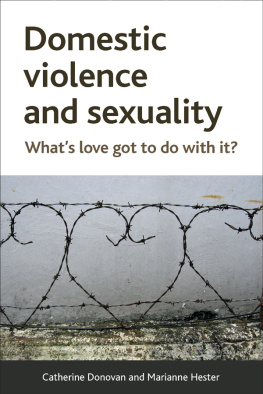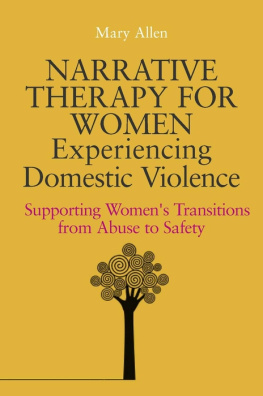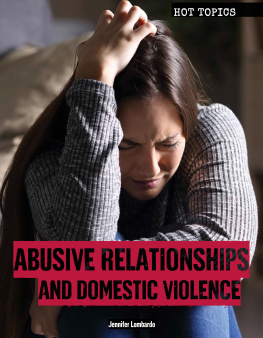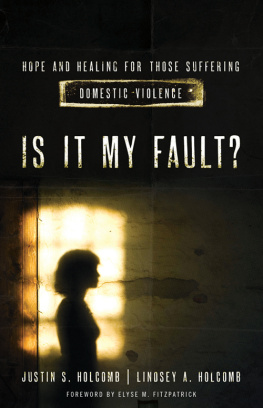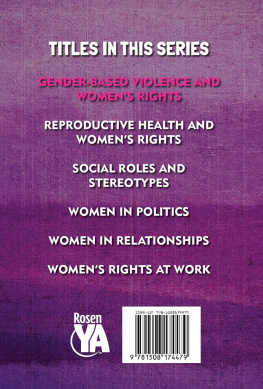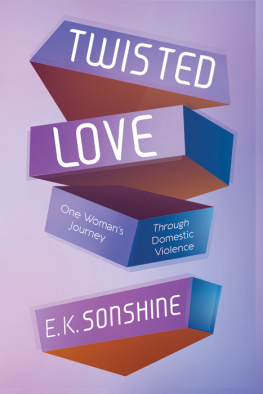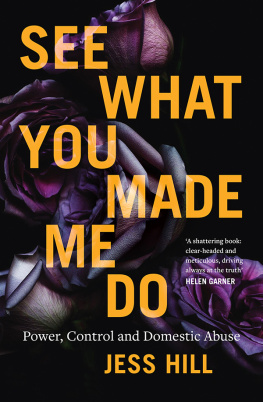Most of this book uses the story ofFred, a fictional man and his family, to allow readers to understand theabuse and abusive situations that men can get into, and where it stems from.Freds experience will not be identical to the experiences you may have, or menthat you know, but it will be similar. It is the situations around Freds lifethat will help you understand how abuse works and how to break the cycle ofabuse. From this you may gain knowledge, get help for others, and even gethealing for yourself.
The story helps you understand themyths and realities of an abusive relationship, particularly one where men arevictims and women are the abusers. To simplify the terms abuser and victimthe author has used them loosely. Nothing is black and white. Often there is not just one abuser and one victim. People can be abusive to each other. Therefore, w hen she refers tothe abuser it does not mean that this person is a fully bad person . A woman may start to recognize that what she is doing is abusive; she may even want to change, but she has not yetlearned how to change. The victim may also have some abusive behaviors.
This book is not about how abusers can change their behavior. The author realizes that some abusers want to change their behavior, but just dont know how. This book is about awareness and understanding for the victims with the hopesthat it may help, not only to reduce domestic violence against men, but againsteveryone. With a little courage we can change ourselves and help the world be abetter place for everyone. Knowledge shines a light into the darkness. Let usnot turn our backs on those who are in need of our help; it may even be you.
Chapter One
Domestic Violence AgainstMen
Do people think I have a tattoo on myforehead that says abuse me? -Fred
Many people think that they get atattoo on their body or forehead when they go through some trauma at the handsof another. Unfortunately, they really do! Their shame covers their whole body.It is not visible to the naked eye, but abusers can spot it from a mile away.They can see the vulnerability, low self-esteem, neediness, unhealthyboundaries, and lack of assertiveness. Victims do not recognize abusers becauseabusive behavior seems normal to them and they only see the best side of theabuser in the beginning stages of a relationship. The abuser is also on theirbest behavior. Once a victim is abused one or more times, this tattoo is thereuntil the potential victim is healed.
As you may know, abuse can run fromone generation to the next. When one parent abuses the other parent, do youthink it is a form of child abuse? You bet; even if the child is treated well,he is still abused by witnessing and internalizing abuse. Its as if thesechildren themselves have been physically and emotionally abused.
This indirect abuse is intimidating toa child. It instills the fear of the loss of a parent due to divorce,separation, or even death. Young children are dependent on their parents fortheir very lives. They often believe that there is something wrong with them;that they are responsible somehow for the abuse they are witnessing.
An abuser craves power andcontrol. It follows that an abusive parent is also controlling with theirchildren, even if they seem to be a good parent to those outside the familycircle. As a result of witnessing abuse and being controlled, the childrenoften grow up to become either an abuser or a victim. This can only be stoppedby the children themselves putting a stop to violence in their own lives and/orone parent leaving the abusive one and becoming well again. It doesnt meanthat the children will be free from abuse, but it usually breaks thegenerational cycle.
Abuse is not only restricted tophysical violence. Abuse or violence can be financial, spiritual, verbal,emotional, psychological, or sexual, to name some common types of abuse. It canbe one, some, all of the above or even more. The listed types of abuse will bediscussed in greater detail during this book.
Domestic abuse happens to:
-Men
-Women
-Children
-Gay Men
-Lesbians
-The Strong
-The Weak
-The Rich
-The Poor
-The Well-educated
-The Under-educated
-In All Religions
-In All Races
-In All Cultures
According to Canadian Statistics onDomestic Violence there has been aconsistency from 2000 to 2011 that is indicative of all North America. 51% ofwomen and 49% of men are at-risk for victimization. These stats are estimatedto be much higher in reality because of lack of reporting.
Reports show that one in four womenare abused by their intimate partner, which is almost four times higher thanthe rate for men (one in 18). This is partially due to the fact that men whoare abused by their intimate partners often do not realize that they are victimsof domestic violence or even criminal assault. They are able to defendthemselves physically so dont seem to recognize the impact of emotional andverbal abuse or abuse by isolation, financial abuse and even physical abuselike pushing or slapping.
Men think they can handle thesituation; they are in denial, they are embarrassed, their pride won't let themacknowledge the abuse, and they dont think the police will believe their story(and they may be right about that). Even the average woman will not ask forhelp until many incidents of abuse have occurred. In all cases of domesticabuse, whether the victim is a man or woman, physical abuse that goesunreported, can escalate to the point of serious injury.
Research from Central University ofLancaster, found that men and women reporting over a 40-year period showed consistentdomestic violence rates. Of those victimizedby their intimate partners, comparing men to women, men are killed at a rate of50%, assaulted at a rate of 30%, and abused emotionally, verbally, andfinancially at a rate of 25%.
In the future, women may findthemselves increasingly likely to be charged with domestic assault, and men justas likely to be offered help and protection.



